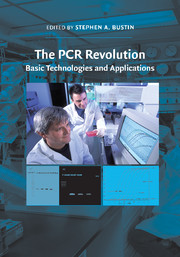Book contents
- Frontmatter
- Contents
- Contributors
- Foreword by Russell Higuchi
- Preface
- I BASIC TECHNOLOGIES
- 1 Real-time polymerase chain reaction
- 2 Thermostable enzymes used in polymerase chain reaction
- 3 Inventing molecular beacons
- 4 Rapid polymerase chain reaction and melting analysis
- 5 Polymerase chain reaction and fluorescence chemistries: deoxyribonucleic acid incarnate
- 6 Analysis of microribonucleic acid expression by quantitative real-time polymerase chain reaction
- 7 Miniaturized polymerase chain reaction for quantitative clinical diagnostics
- 8 The road from qualitative to quantitative assay: What is next?
- 9 Taking control of the polymerase chain reaction
- II APPLICATIONS
- Index
- Plate section
- References
8 - The road from qualitative to quantitative assay: What is next?
Published online by Cambridge University Press: 25 January 2011
- Frontmatter
- Contents
- Contributors
- Foreword by Russell Higuchi
- Preface
- I BASIC TECHNOLOGIES
- 1 Real-time polymerase chain reaction
- 2 Thermostable enzymes used in polymerase chain reaction
- 3 Inventing molecular beacons
- 4 Rapid polymerase chain reaction and melting analysis
- 5 Polymerase chain reaction and fluorescence chemistries: deoxyribonucleic acid incarnate
- 6 Analysis of microribonucleic acid expression by quantitative real-time polymerase chain reaction
- 7 Miniaturized polymerase chain reaction for quantitative clinical diagnostics
- 8 The road from qualitative to quantitative assay: What is next?
- 9 Taking control of the polymerase chain reaction
- II APPLICATIONS
- Index
- Plate section
- References
Summary
The PCR is widely used in many applications throughout the world. It has its secure place in the history of molecular biology as one of the most revolutionary methods ever. The principles of PCR are clear, but how can the reaction procedure be optimized to bring out the best in each assay? What is the status quo and what is next? Where are there areas for improvement?
INTRODUCTION
PCR is defined as a relatively simple heat-stable Taq polymerase–based technique, invented by Kary B. Mullis and coworkers, who were awarded the Nobel Prize for chemistry in 1993 for this discovery. However, this terrain is contested, and many other scientists were instrumental in making PCR work in all kinds of deoxyribonucleic acid (DNA), ribonucleic acid (RNA), and protein (immuno quantitative PCR [qPCR])–based applications. Reverse transcription (RT) followed by PCR represents a powerful tool for messenger RNA (mRNA) quantification. Nowadays, real-time RT–PCR is widely and increasingly used because of its high sensitivity, good reproducibility, and wide dynamic quantification range. Today, quantitative real-time RT–PCR (qRT–PCR) represents the most sensitive method for the detection and quantification of gene expression levels. It has its tremendous advantages in elucidating small changes in mRNA expression levels in samples with low RNA concentrations, from limited tissue samples and in single cell analysis. Sensitivity and reproducibility is a particular requirement of expression profiling, which focuses on the fully quantitative approach for mRNA quantification, rather than simply qualitative analysis.
- Type
- Chapter
- Information
- The PCR RevolutionBasic Technologies and Applications, pp. 110 - 128Publisher: Cambridge University PressPrint publication year: 2009

